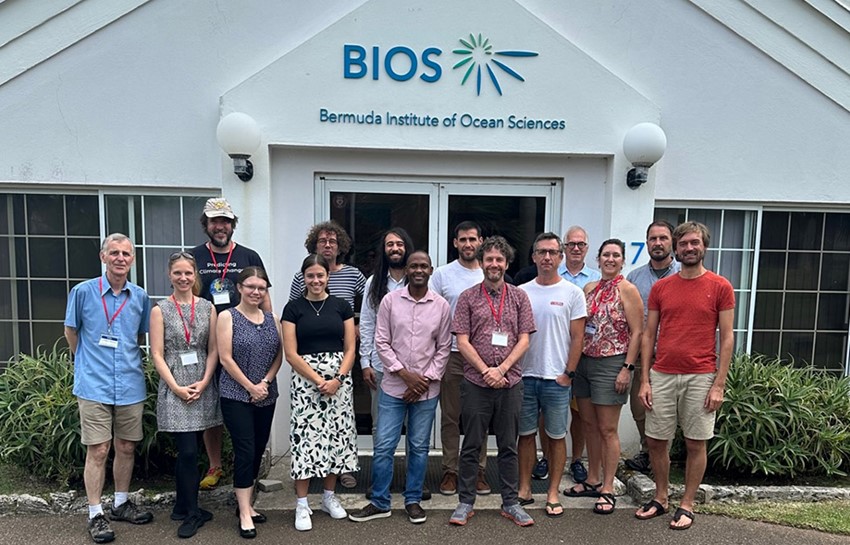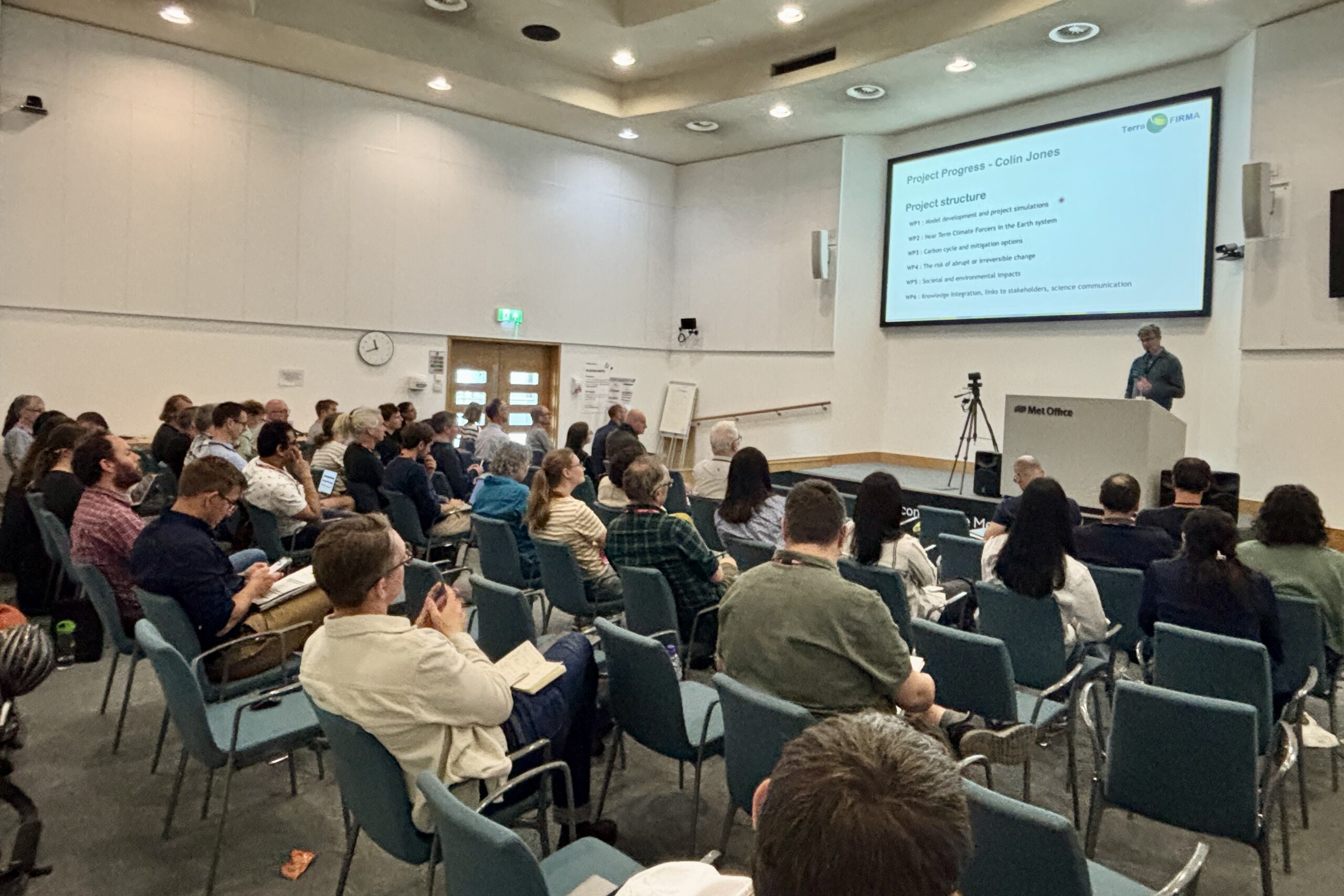News
Fire science Learning AcRoss the Earth system (FLARE) Workshop
Douglas S. Hamilton1, M. M.G. Perron2, Douglas I. Kelley3, Chantelle Burton4, Garry Hayman3, J. Llort5, S. Hebden6 and M. H. Morrill7
1North Carolina State University, USA; 2Université de Brest, France; 3UK Centre for Ecology & Hydrology; 4Met Office, UK; 5Barcelona Supercomputing Center; 6Future Earth Secretariat, Sweden; 7Pyrosketchology, Washington State, USA
FLARE Workshop, Bermuda, and online, 18–21 September 2023
Fire is a key component of the Earth System, modified by, and impacting on human activities. It shapes and regulates terrestrial ecosystems (Pausas et al. 2020), but also drives changes in weather, climate (Hamilton et al. 2018. Kelley et al. 2019), carbon (Lasslop et al. 2019; Burton et al. 2019), and nutrient cycling (Perron et al. 2022) through the many complex interactions of fire and its emissions in the Earth System. From land to ocean, from vegetation to human society, and from the past to the future; fire is a truly transdisciplinary research topic.
Although fire is an integrated component of the Earth System, integrated research across disciplines, institutions, and fire practitioners is currently lacking. As a result, it is difficult to obtain the much-needed holistic understanding of how rapid changes in wildfire activity will impact ecosystems and society in the coming decades.
Diverse expertise from across the geosciences and social sciences is needed to fully appreciate and identify the main challenges in fire science. The changing trends in fire intensity and its spatial reorganization, in response to climate change, are altering the interactions between fire and other components of the Earth System, including society (Kala et al. 2023). This clearly signals an urge for better communication between scientific, societal, stakeholder, and government representatives.
To address this need, the ambition of the FLARE (Fire science Learning AcrRoss the Earth system) workshop was to gather a transdisciplinary international panel of researchers and fire practitioners. Participants discussed the challenges in understanding fire behaviour and its impacts across the world and over varied timeframes, the tools that we have, and the need to address these challenges, as well as how to better communicate across disciplines. The goal is to synthesize this knowledge and formulate a roadmap for more integrated wildfire research over the next five to ten years.
Held from 18–21 September 2023, FLARE gathered experts from disciplines across the Future Earth global research network. Expertise in physical and social science, remote sensing, fire communicators and artists, operational fire scientists, and fire managers were all present. Participants represented 14 countries, and both early-career and gender equity were achieved overall (Fig. 1). The workshop was held in a hybrid format, with 15 onsite participants invited to meet at the Bermuda Institute of Ocean Sciences (BIOS, https://bios.asu.edu) and 22 participants online. The 4-day workshop included lightning presentations from each participant, 20 keynote talks, lively discussions, and 4 in-depth breakout sessions.

Figure1: Scientists, artists, communicators and others gathered at ASU BIOS to share ideas and plan future efforts to improve the understanding of wildfires and their impacts on oceans and other global environments, including society during a workshop; “FLARE: Fire science Learning AcRoss the Earth system”.
The workshop highlighted a poor constraint on “impacts of fires on the Earth System” which stem from a lack of communication between relevant fields of expertise. In particular, a disconnection was identified between the scientific aspect of fire and the societal implications of fire events. Workshop participants identified three main challenges that need to be addressed by the global fire community:
-
Unifying transdisciplinary research around common boundary objects, starting with “Fire’s role in the carbon cycle” (Challenge 1)
Fire plays a significant role in the global carbon cycle, with direct and indirect effects on weather, climate, land and ocean biota, atmospheric composition, and the cryosphere (Bowman et al, 2009). As climate changes, the impact of fire on terrestrial carbon stocks also changes (Burton et al. 2022). However, while often viewed solely as a source of atmospheric carbon, fire also contributes to carbon sequestration through e.g. soil microbial enhancements, post-fire nutrient fertilization, including into the oceans, and through changes in albedo and growing season from aerosols and black carbon deposition. However, understanding fire’s impact on the carbon cycle requires collaboration between different communities and disciplines, including land-based fire researchers, atmospheric scientists, Earth System modellers, observationalists, ocean biogeochemists, social scientists, and stakeholders. Such collaboration holds potential for better comprehending carbon emissions associated with fire and their impact on the environment and socio-cultural practices. Science needs to work proactively to manage fire events and related carbon emissions and assess the impact of human activities on fire dynamics.
-
Better characterizing “Fire and extreme events” (Challenge 2)
Fires have been occurring more frequently and impacting societies and ecosystems differently (UNEP et al., 2022). It is often unclear how an “extreme” fire is defined. Identifying a fire as extreme requires considering multiple spatial and temporal scales and the fire’s impact on human health, infrastructure, carbon emissions, and weather properties. Fire events differ in characteristics, with some being “large” due to the amounts of burned area, and others due to the very high rate of spread. Current models project this trend to continue in many extra-tropical regions due to climate change and how we modify the landscape. The human impact on the landscape often plays a role in fires, such as the legacy of fire suppression in the western USA or deforestation in 2019 Amazon fires (Kelley et al., 2021). Effective communication with various stakeholders is critical to addressing the multifaceted nature of fire research and making a meaningful step towards better understanding and management of fires.
-
Taking a holistic approach to understanding “Fire interactions with humans” (Challenge 3).
Understanding the impact of fire on the carbon cycle requires us to delve deeper into the human dimension. Humans have been using fire for centuries, initially for cooking and heating. However, human activities have increased the incidence, size, severity, and duration of fire events, making it challenging to quantify their role in fire science. To better understand the human dimension of fire, it is crucial to hear the voices of people and communities exposed to fire, including indigenous groups and low-income countries. Additionally, using the FAIR and CARE principles can help make research more accessible and actionable.
The FLARE workshop also included an onsite public engagement event organized by the US Consul General Office of Bermuda. Dr Ben Poulter (NASA) visited students at the Warwick Academy to discuss NASA’s role in Earth science, climate change, and blue carbon ecosystems. Additionally, fire-science illustrators Miriam Morrill and Jessie Thoreson captured the transdisciplinary collaboration process during the workshop, characterising the carbon cycle as a potential boundary object for collaborative global fire science connectivity.
Ongoing work now addresses the identified challenges, and by the end of 2023 a roadmap for coordinated wildfire research, in the form of a white paper, will be produced. As part of the white paper, FLARE plans to include a dedicated early-career researcher perspective on the workshop and its outcomes, as well as recommendations for inclusive fire science across different communities.
Acknowledgements
FLARE received funding from ESA and Future Earth, via their Joint Program (https://futureearth.org/initiatives/funding-initiatives/esa-partnership), PAGES, North Carolina State University (Hamilton’s start-up), and BIOS (https://bios.asu.edu/).
Contact
Douglas S Hamilton: dshamil3@ncsu.edu
References:
Burton et al. (2019), https://doi.org/10.5194/gmd-12-179-2019
Burton et al. (2022) Climate Resil Sustain. https://doi.org/10.1002/cli2.8
Bowman et al. (2009) Science, https://doi.org/10.1126/science.1163886
Hamilton DS et al. (2018) Nat Comms, https://doi.org/10.1038/s41467-018-05592-9
Kala CP (2023) Nat Hazards Res. https://doi.org/10.1016/j.nhres.2023.04.003
Kelley DI et al. (2019) Nat Clim Change, https://doi.org/10.1038/s41558-019-0540-7


